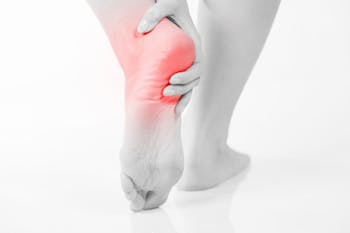
Ankle Anatomy
The ankle joint is also known as the talocrural joint. It is formed by:
- Tibia - large and stronger of the two lower leg bones, which forms the inside part of the ankle
- Fibula - smaller bone of the lower leg, which forms the outside of the ankle
- Talus - a small bone between the tibia, fibula and calcaneus (heel bone)
- Lower (Subtalor) Ankle Joint - formed by the talus, calcaneus and navicular bone
The ends of each of the bones are covered by articular cartilage. The space in the joint is lined with a thin membrane called the synovium. The synovium cushions the joint and secretes a lubricating fluid (synovia), which reduces bone friction and help with fluid movement.
These bones are held together by a set of three strong bands of connective tissue, called ligaments:
- Anterior Tibiofibular Ligament - connects the tibia to the fibula
- Medial Collateral (Detoid) Ligament
- Lateral Collateral Ligament
A number of tendons attach the lower leg muscles to the foot and ankle bones.
Parts of the Foot
The foot has 28 bones and is traditionally divided into three regions:
- The Hindfoot - begins at the ankle joint and stops at the transverse tarsal joint (talonavicular and calcaneal-cuboid joints combined). The hindfoot has two bones: the talus and calcaneus.
- The Midfoot - begins at the transverse tarsal joint and ends where the metatarsals begin - at the tarsometatarsal (TMT) joint. The midfoot has five bones: navicular, cuboid and the three cuneiforms (medial, middle, and lateral).
- The Forefoot - made up of the metatarsals, phalanges, and sesamoids. The forefoot has 21 bones: five metatarsals, fourteen phalanges and two sesamoids (bones embedded within a tendon or a muscle that act like pulleys, providing a smooth surface over which tendons can slide to increase its ability to transmit muscular forces).
...and two columns:
- The Medial Column - a mobile column consisting of the talus, navicular, medial cuneiform, 1st metatarsal, and great toe bones.
- The Lateral Column - a staffer that includes the calcaneus, cuboid, and the 4th and 5th metatarsals.
Physiotherapists (PTs) are experts in the art and science of the evaluation and treatment of human movement dysfunctions. We care for people of all ages and treat a variety of muscle, joint and neurological conditions.
Conditions we have successfully treated:
- Ankle Pain
- Shin Splints
- Ankle Sprains
- Plantar Fasciitis
- Achilles Tendonitis
- Excessive Pronation
- Post Surgical Conditions
- Tibialis Posterior Tendonitis
What are my treatment options?
- Drugs
- Corticosteroid Injections
- Surgery
- Physiotherapy*
Advantages of Physiotherapy:
- No side effects.
- Cost-effective.
- Supported by clinical research*.
- Customized to treat the underlying cause.
Your Recovery Process:
- Pain Relief
- Recovery of Mobility or Stability
- Increased Strength
- Recovery of Walking and Functional Skills
- Independent Care
Components of Your Care:
- A thorough biomechanical evaluation.
- Extensive patient education.
- A customized treatment plan.
- Gentle hands-on techniques to relax the muscles.
- Effective joint mobilization techniques to decrease stiffness.
- Pain relieving modalities such as ice, heat, ultrasound or electrical stimulation.
- Targeted stretching for tight muscles.
- Walking retraining.
- Balance exercises.
- Shoe inserts (orthotic recommendations).
* Cited from the academic journal, JBJS (American). 2006;88; Am J Sports Med 1998 May; 26(3).
Visit our Medical Library for more information on ankle and foot pain.
Are you suffering from foot or ankle pain? Our Brampton clinic has a team of experienced and licensed therapists readily available to assist you. We provide a customized approach to help every individual recover from physical trauma. Call us to arrange a consultation with one of our therapists (905) 497-1311. Get started on your recovery today.

